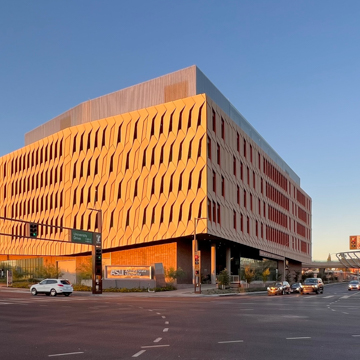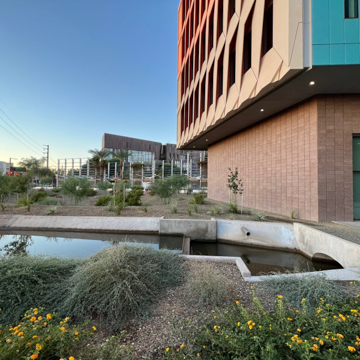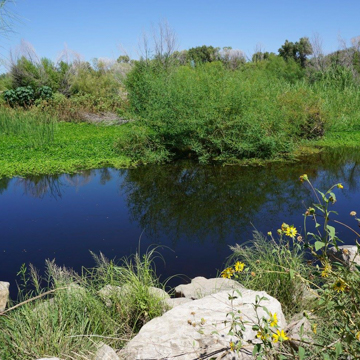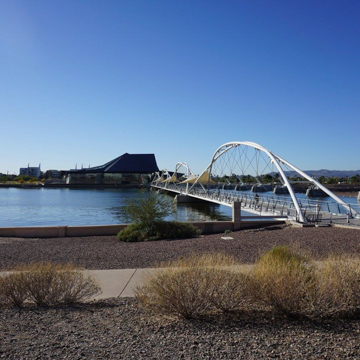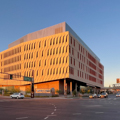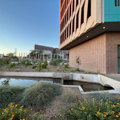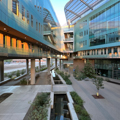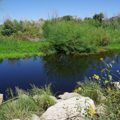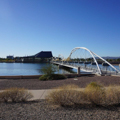You are here
ISTB7
ISTB7 is the seventh building in a series dedicated to Interdisciplinary Science and Technology on the Arizona State University (ASU) Tempe campus. Also known as the Walton Center for Planetary Health, the facility contains high-tech laboratories and hosts offices for several ASU departments and institutes. The building plan is roughly triangular shaped and contains an inner courtyard.
Tempe-based Architekton and Grimshaw of New York created a design guided by sustainability and health. Much of the work occurred during the pandemic, which required consultants, designers, and engineers to coordinate work digitally and remotely to complete the project. ISTB7’s prominent site at the busy intersection of University Drive and Rural Road allows the striking building envelope to be admired from several directions. Notably, there is a 28-foot-grade from the intersection to the top of the site, which presented a unique set of construction challenges. The building’s exterior panels, made of glass-fiber-reinforced concrete, lessen the effects of the bright Arizona sunlight and direct heat gain, while the angling still allows for views from the interior. The panels are evocative of a shed snake skin, serving as a kind of biomimetic metaphor.
The design team took inspiration from something else found in nature: the geode. The hard and textured exterior sharply contrasts the sparkling glass and light-filled inner courtyard. Open-air stairwells provide vertical circulation in the courtyard and patterned glass railings contribute to a geode effect, where the outer envelope is hardened by the elements and the inside is crystalline and reflective.
The courtyard is conceptually formed like Arizona’s natural canyons, since a waterway, one of the modernized Salt River Canals that network through the Phoenix metropolitan area, runs directly through the site and building. The architects accommodated the canal to the benefit of the building, and created a busy yet contemplative inner space around slowly flowing water. Like Ancestral Puebloan cliff dwellings, the building is oriented in such a way that the north side of the building is very open, while the south side is closed. Thus, the courtyard remains fully illuminated in winter but protected from the sun in summer.
ISTB7 is located on a transit-oriented part of the Tempe campus. A signature pedestrian bridge spans University Drive, connecting ISTB7 to a parking structure in an area being developed by ASU called NOVUS.
References
Didonna, Marybeth. “Project Profile: ASU Interdisciplinary Science and Technology Building 7 (ISTB7).” Lab Manager, March 15, 2021. https://www.labmanager.com/project-profile-asu-interdisciplinary-science-and-technology-building-7-istb7-25422
Giusti, Autumn Cafiero. “New ASU Building Puts Science Front and Center.” ENR Southwest, January 10, 2022. https://www.enr.com/articles/53379-new-asu-building-puts-science-front-and-center
Seckel, Scott. “ISTB7: A Building Bridging Our Ancient Past To Our Thriving Future.” ASU News, March 10, 2022. https://news.asu.edu/20220310-creativity-asu-istb7-architecture-ancient-past-thriving-future
Writing Credits
If SAH Archipedia has been useful to you, please consider supporting it.
SAH Archipedia tells the story of the United States through its buildings, landscapes, and cities. This freely available resource empowers the public with authoritative knowledge that deepens their understanding and appreciation of the built environment. But the Society of Architectural Historians, which created SAH Archipedia with University of Virginia Press, needs your support to maintain the high-caliber research, writing, photography, cartography, editing, design, and programming that make SAH Archipedia a trusted online resource available to all who value the history of place, heritage tourism, and learning.














